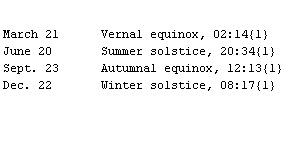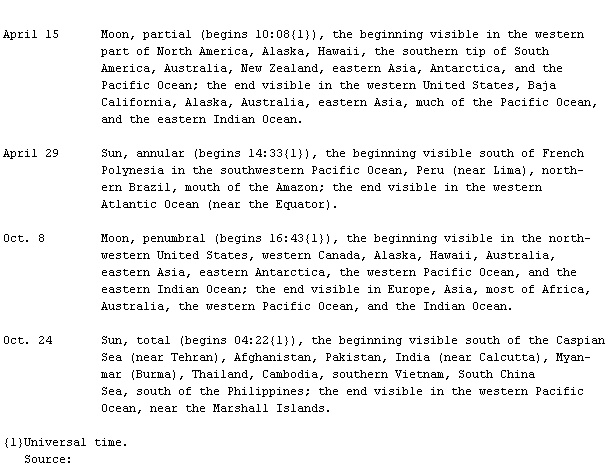- astronomy Table
-
▪ TableEarth Perihelion and Aphelion, 1995Jan. 4 Perihelion, 147,100,000 km (91,403,900 mi) from the SunJuly 4 Aphelion, 152,102,400 km (94,512,200 mi) from the Sun
 Equinoxes and Solstices, 1995March 21 Vernal equinox, 02:14{1}June 20 Summer solstice, 20:34{1}Sept. 23 Autumnal equinox, 12:13{1}Dec. 22 Winter solstice, 08:17{1}
Equinoxes and Solstices, 1995March 21 Vernal equinox, 02:14{1}June 20 Summer solstice, 20:34{1}Sept. 23 Autumnal equinox, 12:13{1}Dec. 22 Winter solstice, 08:17{1} Eclipses, 1995April 15 Moon, partial (begins 10:08{1}), the beginning visible in the westernpart of North America, Alaska, Hawaii, the southern tip of SouthAmerica, Australia, New Zealand, eastern Asia, Antarctica, and thePacific Ocean; the end visible in the western United States, BajaCalifornia, Alaska, Australia, eastern Asia, much of the Pacific Ocean,and the eastern Indian Ocean.April 29 Sun, annular (begins 14:33{1}), the beginning visible south of FrenchPolynesia in the southwestern Pacific Ocean, Peru (near Lima), north-ern Brazil, mouth of the Amazon; the end visible in the westernAtlantic Ocean (near the Equator).Oct. 8 Moon, penumbral (begins 16:43{1}), the beginning visible in the north-western United States, western Canada, Alaska, Hawaii, Australia,eastern Asia, eastern Antarctica, the western Pacific Ocean, and theeastern Indian Ocean; the end visible in Europe, Asia, most of Africa,Australia, the western Pacific Ocean, and the Indian Ocean.Oct. 24 Sun, total (begins 04:22{1}), the beginning visible south of the CaspianSea, south of the Philippines; the end visible in the western PacificOcean, near the Marshall Islands.{1}Universal time.Source:
Eclipses, 1995April 15 Moon, partial (begins 10:08{1}), the beginning visible in the westernpart of North America, Alaska, Hawaii, the southern tip of SouthAmerica, Australia, New Zealand, eastern Asia, Antarctica, and thePacific Ocean; the end visible in the western United States, BajaCalifornia, Alaska, Australia, eastern Asia, much of the Pacific Ocean,and the eastern Indian Ocean.April 29 Sun, annular (begins 14:33{1}), the beginning visible south of FrenchPolynesia in the southwestern Pacific Ocean, Peru (near Lima), north-ern Brazil, mouth of the Amazon; the end visible in the westernAtlantic Ocean (near the Equator).Oct. 8 Moon, penumbral (begins 16:43{1}), the beginning visible in the north-western United States, western Canada, Alaska, Hawaii, Australia,eastern Asia, eastern Antarctica, the western Pacific Ocean, and theeastern Indian Ocean; the end visible in Europe, Asia, most of Africa,Australia, the western Pacific Ocean, and the Indian Ocean.Oct. 24 Sun, total (begins 04:22{1}), the beginning visible south of the CaspianSea, south of the Philippines; the end visible in the western PacificOcean, near the Marshall Islands.{1}Universal time.Source: The Astronomical Almanac for the Year 1995 (1994).
The Astronomical Almanac for the Year 1995 (1994).* * *
Universalium. 2010.
